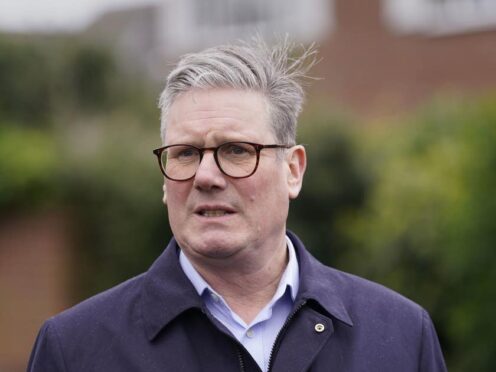Labour would bring an end to the “boom and bust” cycle for the rail industry, Sir Keir Starmer has said, as his party sets out its plans for the rail sector.
The Labour leader said that employees at UK-based train makers were “staring down the barrel of devastating job losses”.
Shadow transport secretary Louise Haigh had earlier announced plans to renationalise the railways if Labour were to win the next election.
On a visit to train manufacturer Hitachi in Newton Aycliffe, Co Durham, Sir Keir said the proposal would be part of a wider set of measures, including a long-term strategy for the rail sector.
Hitachi and Derby-based Alstom have both warned their work in the UK is at risk, with potential for job cuts at both plants.

Sir Keir said: “The workforce here at Hitachi is staring down the barrel of devastating job losses. Communities and local businesses across the North East will be hit hard if our proud manufacturing base here is not preserved.
“This was not inevitable. Both in County Durham and at Alstom in Derby, thousands of jobs are in jeopardy because this Tory government has refused to deliver a proper industrial strategy.
“After 14 years of chaos and uncertainty, they have left our rail manufacturing sector teetering on the brink.
“This is a crisis that must be resolved urgently and must not be allowed to happen again. That’s why, as part of our wider plan to fix Britain’s broken railways, Labour will bring forward a new, long-term strategy for this crucial sector.
“It’s time to end the Tory boom-and-bust. Labour will give rail manufacturing across Britain the secure, bright future it deserves.”
Labour’s long-term strategy for the rail industry would aim to end the stop-and-start they face with their order books, which train makers have said is contributing to their financial situation.
It would also seek to bring down costs for taxpayers, support jobs across the industry, and help the sector decarbonise.
Ms Haigh said: “Britain was the country that created the railways, but under this Government a cycle of boom-and-bust has put the future of our rail manufacturing sector at risk.
“Labour won’t sit back and let another vital British industry be hollowed out due to Conservative chaos.
“Labour will fix Britain’s broken rail system by delivering a publicly owned railway fit for the future, and which delivers for passengers, taxpayers and manufacturers.”
She had earlier said a Labour government would expect to transfer the 10 remaining privately run rail networks to public ownership “well within the first term” by folding existing private passenger rail contracts into a new body as they expire.
The plan was “fully costed” she added, with the taxpayer saving £2.2 billion annually.
However, she said she did not have agreement from shadow chancellor Rachel Reeves that all of those savings could be invested back into the railways.
The Government’s own proposals for rail reform, published in a draft Bill in February, include the creation of a new public sector body named Great British Railways (GBR) to hold responsibility for rail infrastructure and awarding contracts to operate trains.
But a Labour government would create a publicly owned version of GBR led by rail experts rather than Whitehall.
The shadow transport secretary said it was Labour’s ambition to make fares more affordable in the future, but she was unable to commit to this.
Ms Haigh said: “I can’t today set out that we will lower fares, not least because they are incredibly complex and regulation needs reform as well.
“But we have said that we will simplify them, that we will make them more accessible, more transparent and more trustworthy for passengers.”
Transport Secretary Mark Harper said the plan was unfunded, adding: “That means higher taxes on working people.”
But it won the backing of chief executive Keith Williams, who carried out a review into the railways for ministers, and said Labour’s proposals would “take forward the substance of my recommendations to deliver a better railway for passengers and freight”.
A Department for Transport spokesman said: “The Transport Secretary held a constructive meeting with union representatives of the Hitachi workforce last week and we remain in close contact with the company to secure a sustainable future for rail manufacturing at Newton Aycliffe.
“Rail manufacturing plays an important role in growing the UK economy and delivering better services for passengers, we remain committed to supporting the entire sector on the future pipeline of orders which will be strong in the coming years.”
